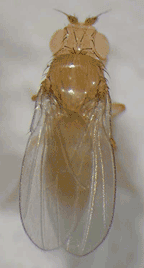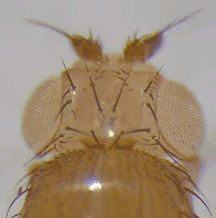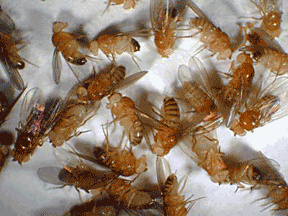WHITE LADY
The animal I’ve been working with in my class lately is the beautiful beastie, Drosophila melanogaster. While I was cleaning out some stocks, I found this lovely example, a pale lady.

She is a white mutant, and so lacks the normal red pigment in her eyes. In addition, she had just recently eclosed from her pupal case, and although her wings looked neat and pressed, her cuticle hadn’t yet fully tanned. She looked even more ghostly when I first spotted her, and was visibly darkening as I put her under the camera.
Here’s a close-up. It’s amazing how every hair has it’s place, and she looks so neat and trim and glossy. Every hair has a nerve or nerves, and is a conduit for olfactory or tactile information, sending constant pulses of information down to her perfect tiny brain.

The white mutant is historically important. This was the first mutant isolated and studied by Thomas Hunt Morgan in 1910, and its discovery has been described in Jonathan Weiner’s Time, Love, Memory (an excellent book, by the way, if you’re at all interested in how science is done).
…after all those tens of thousands of more or less identical red-eyed flies, he found a single fly with white eyes.
Morgan’s wife, Lilian, who was fascinated by his work and who later (after their children were out of the house and busy in school) made important contributions in the laboratory, was pregnant that year; and long afterward the birth of the new baby became mingled in the family history with the arrival of the mutant. Lilian loved to recall the scene when Morgan walked into her hospital room.
“Well, how is the white-eyed fly?” she asked. According to family lore, he was carrying the fly home at night to sleep in a jar next to their bed.
Morgan told her the fly looked feeble but it was hanging on. “And how is the baby?”
Within a week, one of their two new arrivals was old enough to breed (still another reason to work with flies). Morgan paired the white-eyed fly, which was male, with normal virgin female flies, and together they produced 1,237 young flies. The flies’ children (as Morgan called them) had red eyes. The next week, Morgan arranged marriages for all of the children. He was fascinated to see that among the grandchildren, although all of the females had red eyes, about one in two of the males had white eyes. Naturally Morgan thought of Mendel’s peas. When Mendel crossed short peas with tall peas, the first generation was all tall, and in the next generation three quarters of the plants were tall and one quarter was short. Shortness in Mendel’s pea plants is what is now known as a recessive trait, like blue eyes among human beings. Morgan wondered if white eyes among male fruit flies could be a recessive trait too.
As one latter-day drosophilist likes to say now, “In the beginning there was white.” The mutant fly white was the point of entry through which Morgan would establish the modern theory of the gene, the atomic theory of inheritance.

One of the strange things about doing science is that we can look at creatures like this and admire their beauty and appreciate their significance, but of course we also have to be pragmatic. All these pretty little jewels ended up in my fish tanks, where the Danios greatly appreciated their flavor.